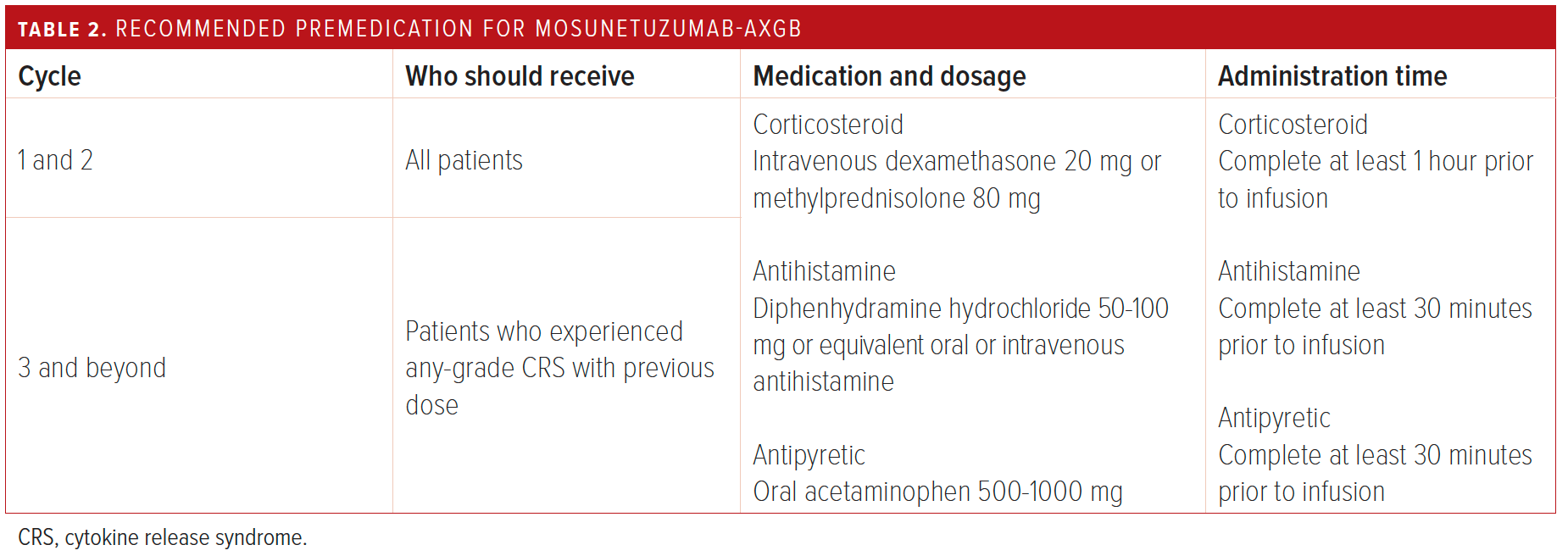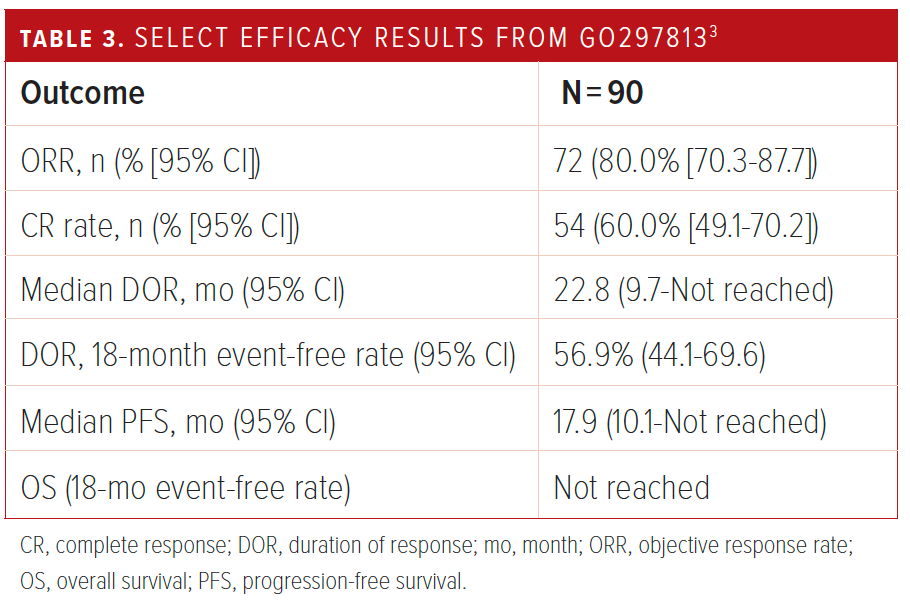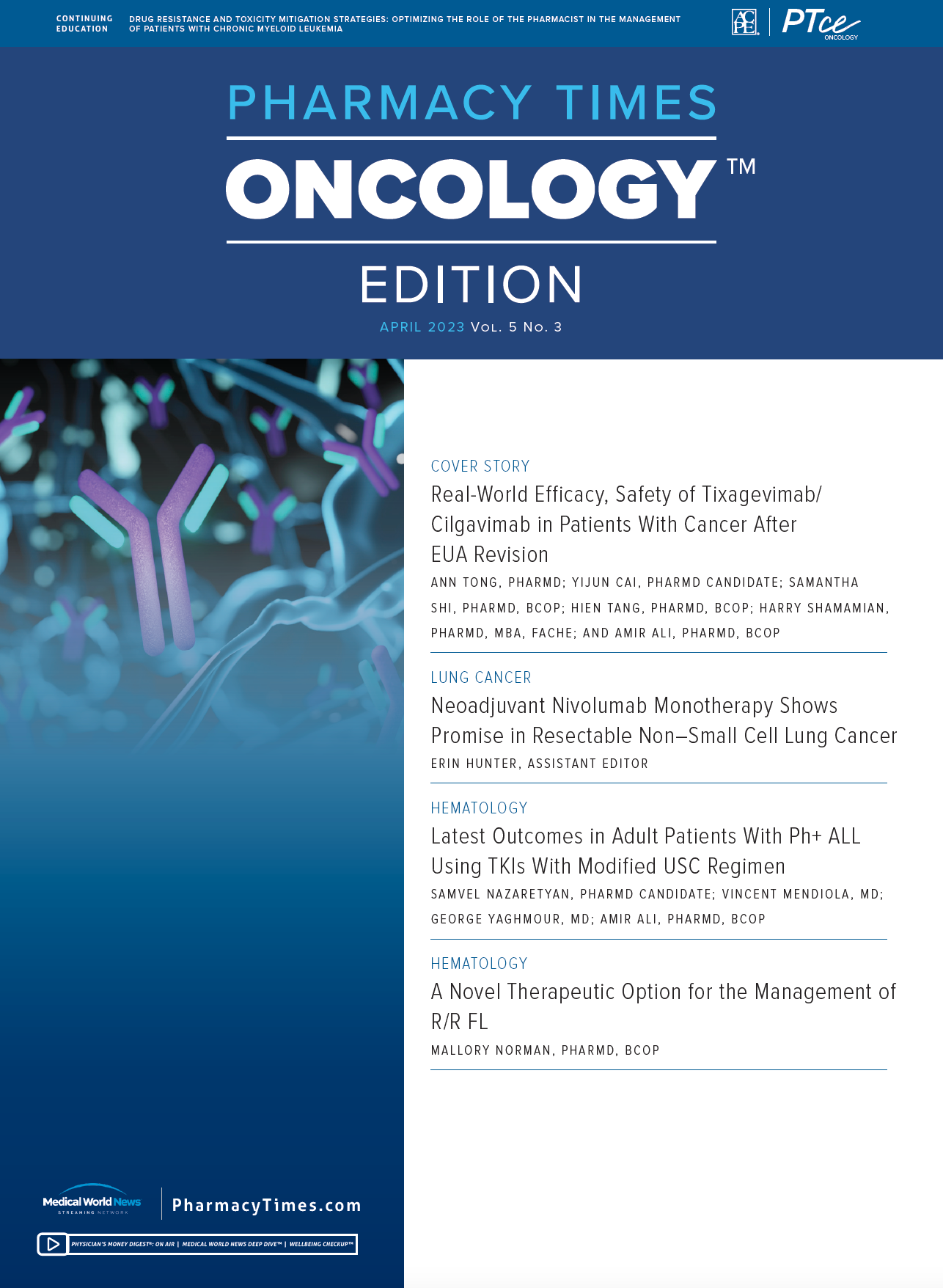Mosunetuzumab-axgb (Lunsumio; Genentech USA) gained accelerated FDA approval in December 2022 for the treatment of relapsed or refractory (R/R) follicular lymphoma (FL) in patients who have received 2 or more previous lines of systemic therapy, including with anti-CD20 and alkylating agents.1 It is the first bispecific antibody approved for the treatment of any subtypes of non-Hodgkin lymphoma.
Mechanism of Action
Like other bispecific T-cell engagers, mosunetuzumab-axgb binds to CD3 receptors on the surface of T cells and to CD20 receptors on the surface of B cells and malignant lymphoma cells. Once activated by mosunetuzumab-axgb, bound T cells will be directed toward B cells to promote lysis of malignant cells, in the process causing the release of proinflammatory cytokines.2
Dosing and Administration
The recommended administration schedule for mosunetuzumab-axgb is a stepwise and loading dose approach to mitigate adverse effects (AEs) and outcompete prior CD20 therapies (Table 1).2 The total number of cycles and duration of therapy for the agent depends on patient response. Those with complete response (CR) after 3 cycles may complete treatment after 8 total cycles. Those with a partial response or stable disease after cycle 3 may receive up to 17 cycles in total.
Treatment with mosunetuzumab-axgb requires the patient be premedicated to prevent or mitigate cytokine release syndrome (CRS), which depends on current cycle and tolerability/response to previous cycles (Table 2). Additionally, premedication is required prior to each dose for cycles 1 and 2, but is necessary only for cycles 3 and beyond in patients who experienced CRS with previous doses.
Clinical Data
The accelerated approval of mosunetuzumab is based on the single-arm, multicenter, phase 2 GO29781 trial (NCT02500407) of patients with R/R FL after 2 or more lines of therapy, including anti-CD20 agents and alkylating agents.3 Its primary end point was CR rate, assessed by independent review committee, and secondary end points included investigatorassessed CR rate, objective response rate (ORR), duration of response (DOR), progression-free survival (PFS), and overall survival (OS).
In the trial, 80% of patients had durable ORR and 60% achieved complete remission. The estimated median DOR was 22.8 months, and DOR at 18 months was 57%. The median PFS was 18 months, and OS was not reached (Table 3).3
Prior to approval of mosunetuzumab-axgb, therapeutic options for the treatment of FL in the R/R setting included PI3K inhibitor therapy with copanlisib (Aliqopa; Bayer), EZH2 inhibitor therapy with tazemetostat (Tazverik; Epizyme, Inc), and anti-CD19 chimeric antigen receptor (CAR) T-cell therapy with axicabtagene ciloleucel (Yescarta; Kite Pharma) or tisagenlecleucel (Kymriah; Novartis).4 Copanlisib has an ORR of 58.7% and a median DOR of 370 days.5 Tazemetostat led to an ORR of 69% in the EZH2-mutated cohort and of 35% in those with EZH2 wildtype disease.6 Median DOR and PFS were 10.9 months for those with the EZH2 mutation and 13 months for those without, and median PFS was 13.8 months and 11.1 months for those with and without the EZH2 mutation, respectively. CAR T-cell therapy in the R/R FL setting had an ORR of 86% to 92%.7,8
Pharmacy Times: Call for Papers
Pharmacy Times Oncology EditionTM and Pharmacy Times Health-System EditionTM are seeking to expand our current coverage offerings to include peer reviewed research on clinical topics and treatment of different disease states.
The publications are seeking to focus on a wide range of therapeutic categories in the oncology and health-system pharmacy space to educate readers and translate innovative clinical discoveries into improved health outcomes for patients. This new focus on clinical research seeks to accelerate adaptation of new therapeutics, techniques, and technologies from the publication’s pages to the clinical setting.
The clinical manuscripts sought will examine different treatments for and management of the different disease states and pharmacologic interventions. Of particular interest are papers that highlight the role of the pharmacist within the overall health care team and provide insight into the impact pharmacists have on patient outcomes. These submissions will be peer-reviewed and published in upcoming editions of Pharmacy Times Oncology Edition and Pharmacy Times Health-System Edition.
Some clinical topics of interest include:
- Transitions of Care
- Immuno-oncology
- Hematology
- Breast Cancer
- Lung Cancer
- Leukemia/Lymphoma
- Ovarian Cancer
- Melanoma
- Head and Neck Cancer
- Antimicrobial Stewardship
- Cardiovascular Disease
- Renal Disease
- Metabolic Disease
- 340B
- Biosimilar Adoption
- Immunizations
- HIV and Pre-exposure Prophylaxis
To send in research paper submissions or if you have any questions, please email Davy James ([email protected]) or Alana Hippensteele ([email protected]).
The response rates and DOR for mosunetuzumabaxgb are comparable to those of CAR-T therapies, presenting an appealing alternative or bridging option for patients when there is a delay in obtaining CAR T-cell therapy. Further studies will likely be needed to determine the best sequence of mosunetuzumab-axgb before and after CAR T-cell therapy in this patient population.
A confirmatory trial is ongoing to assess the role of mosunetuzumab-axgb in R/R FL. The CELESTIMO study (NCT04712097) is a phase 3 trial evaluating the efficacy and safety of mosunetuzumab plus lenalidomide vs rituximab plus lenalidomide in patients with FL whose disease relapsed after 1 or more lines of systemic therapy.9 The results of this study may move mosunetuzumab to the second-line setting for patients with relapsed disease, for whom current options generally include chemotherapeutic agents with regimens such as CHOP (bendamustine and cyclophosphamide, doxorubicin, vincristine, and prednisone). Older adults and patients with poor performance status may tolerate mosunetuzumab-axgb better than these options.
Adverse Effects
The most common AEs seen with mosunetuzumab-axgb were CRS (44%), fatigue (37%), and headache (31%).3 The most common grade 3 and 4 AEs were neutropenia (27%), hypophosphatemia (17%), hyperglycemia (8%), and anemia (8%).
CRS warrants close monitoring, as 42% of patients experienced grade 1 to 2 and 1% experienced grades 3 and 4. CRS occurred predominantly during cycle 1 and was mostly associated with dose escalation between days 1 and 15, with a median time to CRS onset of 5 hours after the start of infusion on cycle 1, day 1, and 27 hours after the start of infusion on cycle 1, day 15. Of those who experienced CRS, 10% were treated with both corticosteroids and tocilizumab. Based on the relatively low rates and severity of CRS, there are no recommendations listed in the prescribing information regarding inpatient admission for CRS monitoring.
Upon CRS occurrence, a total of 21 (23%) patients in the GO29781 study were admitted for monitoring and/or treatment. Hospitalization should be considered for subsequent infusions after a grade 2 CRS event and is recommended for subsequent infusions after a grade 3 CRS event.
A significant advantage of mosunetuzumab-axgb therapy, particularly for older patients, is that most may be safely treated in the outpatient setting. Based on the safety results of G029781, older patients have a lower disease burden and are less likely to experience CRS. However, it is still imperative to properly educate them about common signs and symptoms of CRS, including fever, chills, tachycardia, headache, dizziness, and shortness of breath.
Warnings and Precautions
Mosunetuzumab-axgb has warnings and precautions listed for CRS; cytopenias (including neutropenia, anemia, and thrombocytopenia); serious or fatal infections, including opportunistic infections; neurologic toxicity; and tumor flare. Neurological events related to mosunetuzumab were consistent with immune effector cell–associated neurotoxicity syndrome and included confusional state (3%), disturbance in attention (1%), and cognitive disorder (1%), all of which were grade 1 and resolved without requiring treatment discontinuation. Tumor flare occurred in 3% of patients, with 1 grade 2 pleural effusion on day 43 of therapy and 2 grade 3 events on days 11 and 17, respectively.3
Pregnancy and Lactation
Prior to initiation of mosunetuzumab-axgb treatment, it is recommended that pregnancy status be verified and that those who may become pregnant be advised to use effective contraception during treatment and for 3 months after the last dose.
Because mosunetuzumab-axgb is a humanized monoclonal IgG antibody, it may cross the placenta, as does human IgG. Although animal reproduction studies have not been conducted, based on its mechanism, in utero exposure may cause B-cell lymphocytopenia in exposed infants. Although it is not known whether this agent is present in breast milk, in light of the presence of human IgG in breast milk, breastfeeding is not recommended during treatment and for 3 months after the last dose.
About the Author
Mallory Norman, PharmD, BCOP, is a clinical hematology pharmacist at Smilow Cancer Hospital/Yale New Haven Health in Connecticut.
References
1. FDA grants accelerated approval to mosunetuzumab-axgb for relapsed or refractory follicular lymphoma. FDA. December 22, 2022. Accessed March 17, 2023. https://www.fda.gov/drugs/resources-information-approved-drugs/fda-grants-accelerated-approvalmosunetuzumab-axgb-relapsed-or-refractory-follicular-lymphoma
2. Mosunetuzumab-axgb. Prescribing information. Genentech; 2022. Accessed March 17, 2023. https://www.accessdata.fda.gov/drugsatfda_docs/label/2022/761263s000lbl.pdf
3. Budde LE, Sehn LH, Matasar M, et al. Safety and efficacy of mosunetuzumab, a bispecific antibody, in patients with relapsed or refractory follicular lymphoma: a singlearm, multicentre, phase 2 study. Lancet Oncol. 2022;23(8):1055-1065. doi:10.1016/S1470-2045(22)00335-7
4. NCCN. B-cell lymphomas, version 2.2023. Accessed March 17, 2023. https://www.nccn.org/professionals/physician_gls/pdf/b-cell.pdf
5. Dreyling MH, Santoro A, Leppa S, et al. Copanlisib in patients with relapsed or refractory follicular lymphoma. Clin Oncol. 2017;35(suppl 15):7535-7535. doi:10.1200/JCO.2017.35.15_SUPPL.7535
6. Morschhauser F, Tilly H, Chaidos A, et al. Tazematostat for patients with relapsed or refractory follicular lymphoma: an open-label, single-arm, multicentre, phase 2 trial. Lancet Oncol. 2020;21(11):1433-1442. doi:10.1016/S1470-2045(20)30441-1
7. Fowler NH, Dickinson M, Dreyling M, et al. Tisagenlecleucel in adult relapsed or refractory follicular lymphoma: the phase 2 ELARA trial. Nat Med. 2022;28(2):325-332. doi:10.1038/s41591-021-01622-0
8. Jacobson CA, Chavez JC, Sehgal AR, et al. Axicabtagene ciloleucel in relapsed or refractory indolent non-Hodgkin lymphoma (ZUMA-5): a single-arm, multicentre, phase 2 trial. Lancet Oncol. 2022;23(1):91-103. doi:10.1016/S1470-2045(21)00591-X
9. Nastoupil LJ, Morschhauser F, Scholz CW, et al. CELESTIMO: a phase III trial evaluating the efficacy and safety of mosunetuzumab plus lenalidomide versus rituximab plus lenalidomide in patients with relapsed or refractory follicular lymphoma who have received > 1 line of systemic therapy. J Clin Oncol. 2022;40(suppl 16):TPS7588. doi:10.1200/JCO.2022.40.16_suppl.TPS7588









